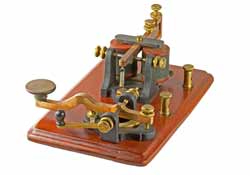Morse Telegraph Sounder
A telegraph sounder was equally important as the Morse key in early telegraph systems.
Morse Telegraph History Includes:
Morse telegraph history
Morse keys development
Vibroplex & mechanical bug keys
Telegraph sounder
Morse inker
Samuel Morse
Fascinating facts
Morse code SOS message
Morse keys:
Clipsal key
Camelback
Walters Electrical Patt 1056A Post Office key
Steel lever Morse telegraph key
RAF Bathtub Morse key
Samson ETM-5C electronic keyer
The Morse telegraph sounder was enabled the Morse characters coming along the telegraph line to be heard.
The telegraph sounder was the most widely used form of instrument to receive the incoming Morse code. The telegraph sounders could be made relatively small and robust, enabling them to be taken along with the telegraph operator as he travelled around. It even enabled operators to move along the line as necessary to send their messages.

How telegraph sounders started in use
The original Morse patent for a telegraph system specified what was termed a Morse Register. This consisted of a machine where pulses of electricity caused the two vertical electromagnets to attract an iron bar. The iron bar was attached to a horizontal brass lever arm which was caused to press a metal stylus against a strip of paper tape which was pulled through a pair of rollers by the clockwork mechanism. This caused short and long marks to be embossed on the paper.
Operators soon discovered that they could read the messages coming in on the registers by ear. As a result, 'sounders' using a very similar construction in terms of the electromagnets started to be used.
What is a Morse telegraph sounder?
Rather than producing the intermittent note that is always associated with Morse code radio signals, the telegraph sounder produced a series of clicks as the electromagnet opens and closes - hence the name telegraph sounder.
Typically a telegraph sounder would consist of two electromagnets made of wire coiled onto a former around an iron core. As the iron core had a high permeability, this enabled the effect of the current to produce a much higher level of magnetism.
The construction of the overall sounder provided for a steel bar to be attracted by the electromagnets when current passed through the coils.
The steel bar was attached to a non-magnetic level which was normally made from brass, but could have been aluminium.

When the magnets were activated the lever was pulled down onto an adjustable screw making a distinctive 'click' as it was stopped.
When the current ceased to pass, i.e. at the end of the Morse symbol, the lever would return to its normal non-activated state, hitting another screw stop with a slightly different clicking noise.
Telegraph operators became very used to the noises made by the sounders and became adept at reading the incoming Morse code from them.

Key-on-Base, KOB
Often telegraph operators would be itinerant, moving from place to place as work arose.
because they became used to their keys and sounders they would own their own keys and sounders. The most convenient way to do this was to mount a key and a sounder on a single base.

The name 'key-on-base' became prevalent and described a combination of a Morse key and telegraph sounder mounted on the same base.
 Written by Ian Poole .
Written by Ian Poole .
Experienced electronics engineer and author.
More History:
Radio history timeline
History of the radio
Ham radio history
Coherer
Crystal radio
Magnetic detector
Spark transmitter
Morse telegraph
Valve / tube history
PN junction diode invention
Transistor
Integrated circuit
Quartz crystals
Classic radios
Mobile telecoms history
Vintage mobile phones
Return to History menu . . .




